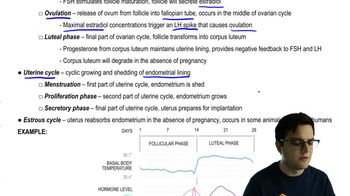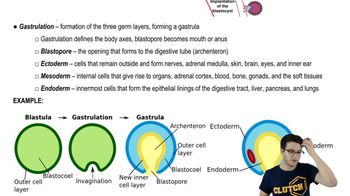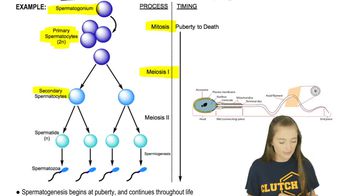Table of contents
- 1. Introduction to Biology2h 40m
- 2. Chemistry3h 40m
- 3. Water1h 26m
- 4. Biomolecules2h 23m
- 5. Cell Components2h 26m
- 6. The Membrane2h 31m
- 7. Energy and Metabolism2h 0m
- 8. Respiration2h 40m
- 9. Photosynthesis2h 49m
- 10. Cell Signaling59m
- 11. Cell Division2h 47m
- 12. Meiosis2h 0m
- 13. Mendelian Genetics4h 41m
- Introduction to Mendel's Experiments7m
- Genotype vs. Phenotype17m
- Punnett Squares13m
- Mendel's Experiments26m
- Mendel's Laws18m
- Monohybrid Crosses16m
- Test Crosses14m
- Dihybrid Crosses20m
- Punnett Square Probability26m
- Incomplete Dominance vs. Codominance20m
- Epistasis7m
- Non-Mendelian Genetics12m
- Pedigrees6m
- Autosomal Inheritance21m
- Sex-Linked Inheritance43m
- X-Inactivation9m
- 14. DNA Synthesis2h 27m
- 15. Gene Expression3h 20m
- 16. Regulation of Expression3h 31m
- Introduction to Regulation of Gene Expression13m
- Prokaryotic Gene Regulation via Operons27m
- The Lac Operon21m
- Glucose's Impact on Lac Operon25m
- The Trp Operon20m
- Review of the Lac Operon & Trp Operon11m
- Introduction to Eukaryotic Gene Regulation9m
- Eukaryotic Chromatin Modifications16m
- Eukaryotic Transcriptional Control22m
- Eukaryotic Post-Transcriptional Regulation28m
- Eukaryotic Post-Translational Regulation13m
- 17. Viruses37m
- 18. Biotechnology2h 58m
- 19. Genomics17m
- 20. Development1h 5m
- 21. Evolution3h 1m
- 22. Evolution of Populations3h 52m
- 23. Speciation1h 37m
- 24. History of Life on Earth2h 6m
- 25. Phylogeny2h 31m
- 26. Prokaryotes4h 59m
- 27. Protists1h 12m
- 28. Plants1h 22m
- 29. Fungi36m
- 30. Overview of Animals34m
- 31. Invertebrates1h 2m
- 32. Vertebrates50m
- 33. Plant Anatomy1h 3m
- 34. Vascular Plant Transport2m
- 35. Soil37m
- 36. Plant Reproduction47m
- 37. Plant Sensation and Response1h 9m
- 38. Animal Form and Function1h 19m
- 39. Digestive System10m
- 40. Circulatory System1h 57m
- 41. Immune System1h 12m
- 42. Osmoregulation and Excretion50m
- 43. Endocrine System4m
- 44. Animal Reproduction2m
- 45. Nervous System55m
- 46. Sensory Systems46m
- 47. Muscle Systems23m
- 48. Ecology3h 11m
- Introduction to Ecology20m
- Biogeography14m
- Earth's Climate Patterns50m
- Introduction to Terrestrial Biomes10m
- Terrestrial Biomes: Near Equator13m
- Terrestrial Biomes: Temperate Regions10m
- Terrestrial Biomes: Northern Regions15m
- Introduction to Aquatic Biomes27m
- Freshwater Aquatic Biomes14m
- Marine Aquatic Biomes13m
- 49. Animal Behavior28m
- 50. Population Ecology3h 41m
- Introduction to Population Ecology28m
- Population Sampling Methods23m
- Life History12m
- Population Demography17m
- Factors Limiting Population Growth14m
- Introduction to Population Growth Models22m
- Linear Population Growth6m
- Exponential Population Growth29m
- Logistic Population Growth32m
- r/K Selection10m
- The Human Population22m
- 51. Community Ecology2h 46m
- Introduction to Community Ecology2m
- Introduction to Community Interactions9m
- Community Interactions: Competition (-/-)38m
- Community Interactions: Exploitation (+/-)23m
- Community Interactions: Mutualism (+/+) & Commensalism (+/0)9m
- Community Structure35m
- Community Dynamics26m
- Geographic Impact on Communities21m
- 52. Ecosystems2h 36m
- 53. Conservation Biology24m
44. Animal Reproduction
Animal Reproduction
Problem 4c
Textbook Question
Textbook QuestionTrue or false: The corpus luteum is retained upon implantation due to the presence of the hormone human chorionic gonadotropin (hCG).
 Verified step by step guidance
Verified step by step guidance1
Step 1: Understand the terms in the question. The corpus luteum is a temporary endocrine structure in female ovaries that is involved in the production of relatively high levels of progesterone, moderate levels of estradiol, and inhibin A. Human chorionic gonadotropin (hCG) is a hormone produced primarily in the placenta during pregnancy.
Step 2: Recall the role of the corpus luteum. After ovulation, the corpus luteum forms from the follicle that released the egg. It produces hormones, particularly progesterone, which prepares the uterus for implantation of a fertilized egg.
Step 3: Recall the role of hCG. After a fertilized egg implants into the uterus, the developing placenta begins releasing hCG. This hormone signals the corpus luteum to continue producing progesterone to prevent menstruation and support the early pregnancy.
Step 4: Connect the information. The presence of hCG indeed helps to maintain the corpus luteum, which is crucial in the early stages of pregnancy until the placenta can fully take over hormone production.
Step 5: Answer the question. Based on the information, the statement 'The corpus luteum is retained upon implantation due to the presence of the hormone human chorionic gonadotropin (hCG)' is true.
Recommended similar problem, with video answer:
 Verified Solution
Verified SolutionThis video solution was recommended by our tutors as helpful for the problem above
Video duration:
3mPlay a video:
Was this helpful?
Key Concepts
Here are the essential concepts you must grasp in order to answer the question correctly.
Corpus Luteum
The corpus luteum is a temporary endocrine structure formed from the ovarian follicle after ovulation. It produces hormones, primarily progesterone, which are crucial for maintaining the uterine lining and supporting early pregnancy. If pregnancy occurs, the corpus luteum is retained; if not, it degenerates.
Recommended video:
Guided course

Menstrual Cycle
Human Chorionic Gonadotropin (hCG)
Human chorionic gonadotropin (hCG) is a hormone produced by the placenta shortly after implantation. Its primary role is to signal the corpus luteum to continue producing progesterone, which is essential for sustaining the pregnancy in its early stages. hCG is also the hormone detected in pregnancy tests.
Recommended video:
Guided course

The Human Population
Implantation
Implantation is the process by which a fertilized egg attaches itself to the uterine lining. This event is critical for establishing a pregnancy, as it allows for the exchange of nutrients and waste between the mother and the developing embryo. Successful implantation triggers hormonal changes, including the production of hCG.
Recommended video:
Guided course

Implantion and Gastrulation

 5:44m
5:44mWatch next
Master Sexual and Asexual Reproduction with a bite sized video explanation from Jason Amores Sumpter
Start learningRelated Videos
Related Practice


































































